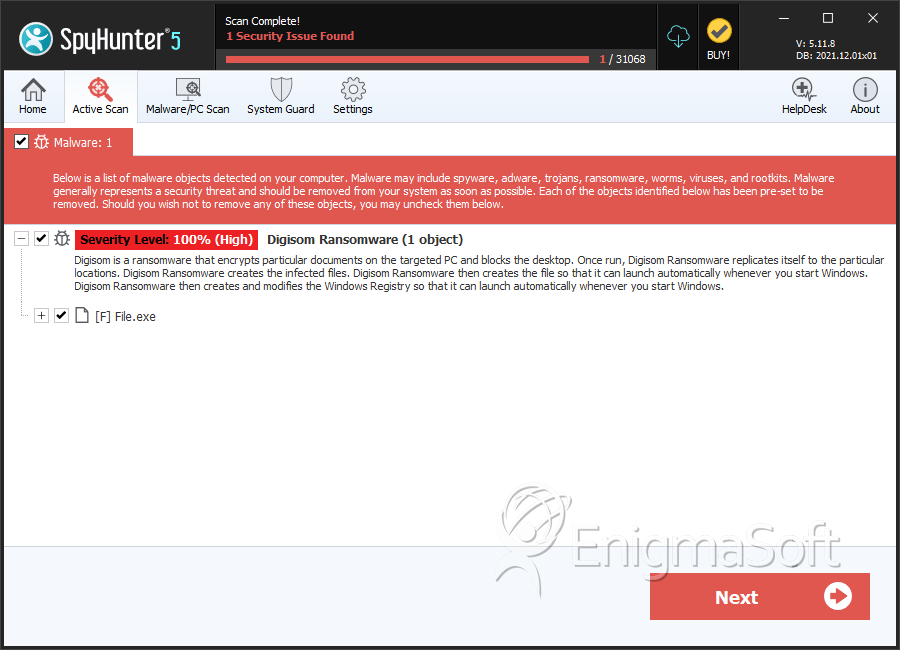Digisom Ransomware
The Digisom Ransomware is a ransomware Trojan that enters a computer silently, without alerting the victim of its presence until the attack has been carried out. Like other ransomware Trojans, the Digisom Ransomware encrypts the victim's files and then demands the payment of a ransom in exchange for the decryption key required to restore the affected files. During its encryption attack, the Digisom Ransomware will rename the affected files by appending the string '[three random characters].x' to the end of the file's extension. After encrypting the victim's files, the Digisom Ransomware will alter the infected computer's Desktop image so that it becomes a black screen, and drops ten text files on the Desktop with names like 'the Digisom Readme0.txt,' 'the Digisom Readme1.txt,' 'the Digisom Readme2.txt,' going up all the way to 'the Digisom Readme9.txt'. The Digisom Ransomware will display a pop-up window with a countdown timer, threatening to delete a random file every two hours permanently.
Table of Contents
The Digisom Ransomware Asks for an Affordable Ransom Fee
The Digisom Ransomware's ransom note claims that the victim's files have been encrypted and are not recoverable without access to the private key. To purchase the key, the victims are asked to pay 0.2 BitCoin, approximately $220 USD at the current exchange rate. PC security analysts strongly advise computer users against paying this ransom. Con artists will rarely keep their word to provide the decryption key, and paying the Digisom Ransomware ransom allows these people to continue carrying out ransomware attacks. Instead, PC security analysts strongly advise computer users to take steps to protect their computers and files from these attacks. The following is the ransom note displayed by the Digisom Ransomware in its text files:
'Your important files were encrypted on this computer: photos, videos, documents, etc. You can verify this by opening them.
To save your files, you need a private key to decrypt it.
The single copy of private key, which will allow you to unlock the files, is located on a secret server on the internet; the server will destroy the key within 48 hours after encryption completed. After that, nobody are able to restore the files.
To retrieve the private key, you need to pay 0.2 bitcoins. Check out the website on how to make payment: http://www.the Digisom.pw
YOUR UNIQUE ID TO FIND KEY:'
The victims of the Digisom Ransomware will be greeted by the following message after connecting to the payment website:
'1. Get Bitcoins (BTC) at localbitcoins.com if you don't already have any.
2. Send 0.20004084 Bitcoins (in ONE payment) to the address below.
If you send any other bitcoin amount, payment system will ignore it !
Send EXACTLY 0.20004084 BTC (plus fees) to: 1FCuCww75NtxtVJHsvwaWJsphLsT1tRAoL
Bitcoins have not yet been received.
If you have already sent Bitcoins (the exact Bitcoin sum in one payment as shown in the box below), please wait a few minutes to receive them by Bitcoin Payment System. If you send any other sum, Payment System will ignore the transaction and you will need to send the correct sum again, or contact the site owner for assistance.'
What is the Goal of Threats Such as the Digisom Ransomware
There are countless ransomware Trojans that are active currently. There are also many different tactics used by these threats, although many ransomware Trojans are virtually identical to the Digisom Ransomware. The most common way of distributing threats like the Digisom Ransomware is through spam email attachments. The Digisom Ransomware also may be distributed through file sharing networks, threats scripts and advertisements on hijacked websites, or by hacking into the victims' computers directly. Because of this, having a reliable security program that is fully up-to- date is an essential part of protecting your computer from these threats. However, the best protection against the Digisom Ransomware and other ransomware attacks is to have backups of all important files on an external memory device or the cloud. If computer users can restore the affected files from a backup copy, then any leverage that the people responsible for the Digisom Ransomware have over the victim will be gone completely. This is the single best way to limit the damage from these attacks.
SpyHunter Detects & Remove Digisom Ransomware

File System Details
| # | File Name | MD5 |
Detections
Detections: The number of confirmed and suspected cases of a particular threat detected on
infected computers as reported by SpyHunter.
|
|---|---|---|---|
| 1. | File.exe | 5559da82149923247fc9d02a04004a13 | 0 |


Submit Comment
Please DO NOT use this comment system for support or billing questions. For SpyHunter technical support requests, please contact our technical support team directly by opening a customer support ticket via your SpyHunter. For billing issues, please refer to our "Billing Questions or Problems?" page. For general inquiries (complaints, legal, press, marketing, copyright), visit our "Inquiries and Feedback" page.